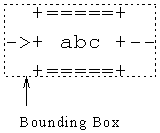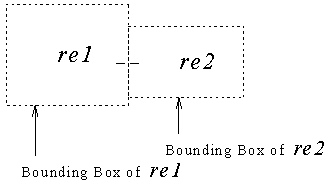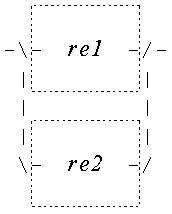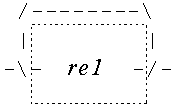Given a simple syntax for describing regular expressions, one can find a graphical representation
for a given regular expression using ASCII characters like `-', `', `+', and `/'.
The syntax we use can be drawn by using four different patterns:
- "abc" is the terminal string `abc', represented as
Note that the graphical representation of every expression has a bounding box. This is the
smallest rectangle that surrounds the graphic.
- (re1 re2) is a sequence of first expression re1, then expression re2, represented as
The two expressions re1 and re2 have to be concatenated such that the bounding boxes of
the two expressions touch and such that the `-' on the right of re1 matches the `-' on the
left of re2.
- {re1 re2} represents alternatives, either re1 or re2, represented as
the number of `|' characters that has to be added depends on the shapes of re1 and re2.
There has to be exactly one straight blank line between the bounding box of the graphical
representation of re1 and the bounding box of re2. If necessary, also a number of `-'
characters has to be added on the right side of re1 or re2, to make the drawing possible. Note
that the `-' on the left of re1 and re2 matches the `
\' character and that the `-'
on the right of re1 and re2 matches the `
\' character in the drawing.
- [re1] is a 1-or-more repetition of re1, represented as
Note that the `-' on the left of re1 matches the `
\' character and that the `-' on the right of
re1 matches the `/' character in the drawing.
For example the graphical representation for the regular expression
{("f" "bar") ["c"]} looks like:
+===+ +=====+
---\->+ f +--->+ bar +--/-->
| +===+ +=====+ |
| |
| /---------\ |
| | +===+ | |
\-\->+ c +--/--------/
+===+
Write a program that reads syntax rules and prints the size of the graphical representation.
For esthetic reasons, the entire graphic has a `-' on the left and a `->' on the right.
The input consists of a line holding the number of test cases, followed by the input expressions
(one per line). The expressions are formatted according to the following grammar:
expression :: sequence | alternatives | repetition | terminal
sequence :: ( ws expression expression ) ws
alternatives :: { ws expression expression } ws
repetition :: [ ws expression ] ws
terminal :: " character* " ws
ws :: (<space> | <tab>)*
character :: <any character except " and control-characters (ASCII 0..31)>
Note that the grammar is specified according to the following notational conventions:
x y sequence: x followed by y
x| y choice: x or y
x* repetition: zero or more occurrences of x
< > used for describing a character
For each expression, output a line of the form XxY with X and Y the width and height of
the graphical representation of that expression.
1
{("f" "bar") ["c"]}
28x8
Miguel Revilla
2004-09-16



